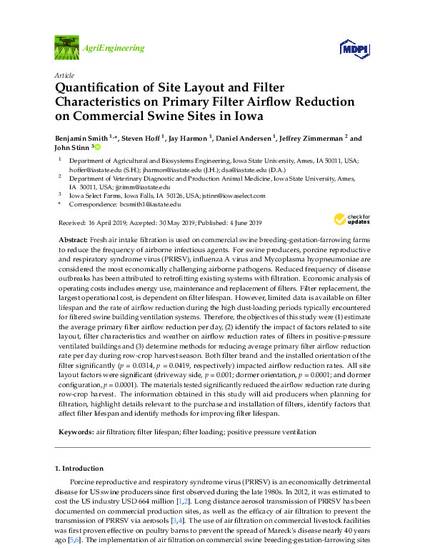
Fresh air intake filtration is used on commercial swine breeding-gestation-farrowing farms to reduce the frequency of airborne infectious agents. For swine producers, porcine reproductive and respiratory syndrome virus (PRRSV), influenza A virus and Mycoplasma hyopneumoniae are considered the most economically challenging airborne pathogens. Reduced frequency of disease outbreaks has been attributed to retrofitting existing systems with filtration. Economic analysis of operating costs includes energy use, maintenance and replacement of filters. Filter replacement, the largest operational cost, is dependent on filter lifespan. However, limited data is available on filter lifespan and the rate of airflow reduction during the high dust-loading periods typically encountered for filtered swine building ventilation systems. Therefore, the objectives of this study were (1) estimate the average primary filter airflow reduction per day, (2) identify the impact of factors related to site layout, filter characteristics and weather on airflow reduction rates of filters in positive-pressure ventilated buildings and (3) determine methods for reducing average primary filter airflow reduction rate per day during row-crop harvest season. Both filter brand and the installed orientation of the filter significantly (p = 0.0314, p = 0.0419, respectively) impacted airflow reduction rates. All site layout factors were significant (driveway side, p = 0.001; dormer orientation, p = 0.0001; and dormer configuration, p = 0.0001). The materials tested significantly reduced the airflow reduction rate during row-crop harvest. The information obtained in this study will aid producers when planning for filtration, highlight details relevant to the purchase and installation of filters, identify factors that affect filter lifespan and identify methods for improving filter lifespan.
Available at: http://works.bepress.com/steven_hoff/166/

This article is published as Smith, Benjamin, Steven Hoff, Jay Harmon, Daniel Andersen, Jeffrey Zimmerman, and John Stinn. "Quantification of Site Layout and Filter Characteristics on Primary Filter Airflow Reduction on Commercial Swine Sites in Iowa." AgriEngineering 1, no. 2 (2019): 291-302. DOI: 10.3390/agriengineering1020022. Posted with permission.